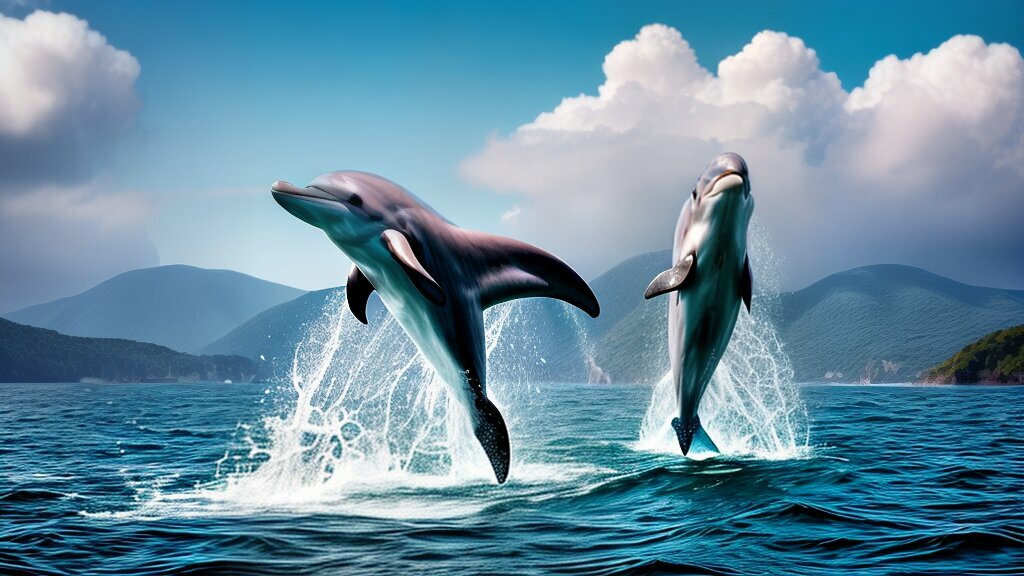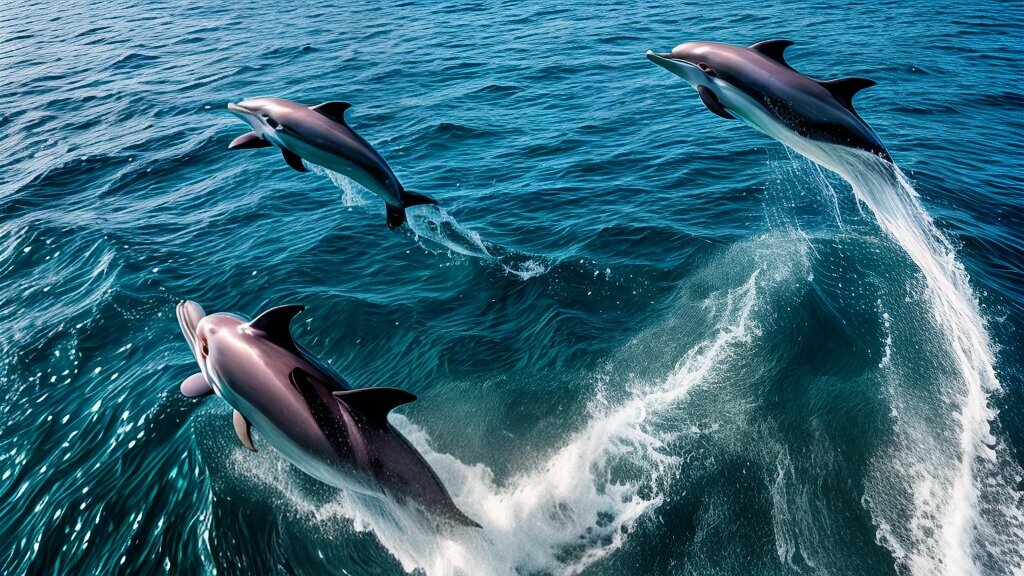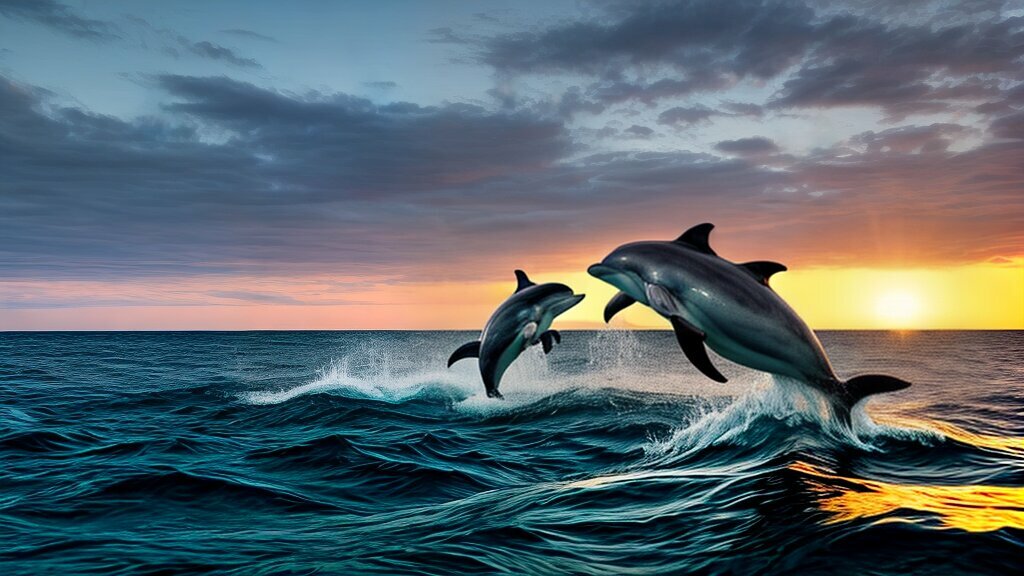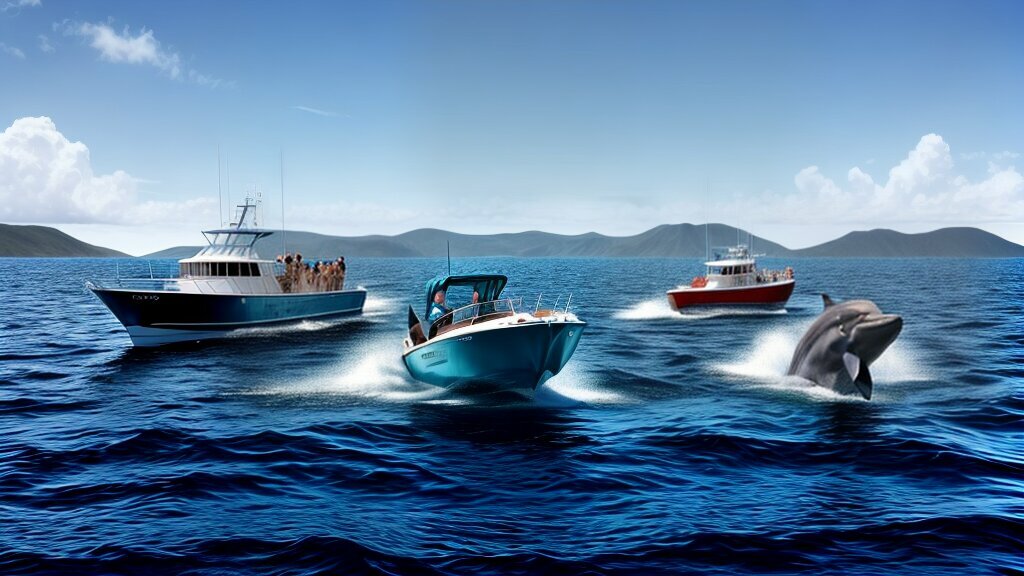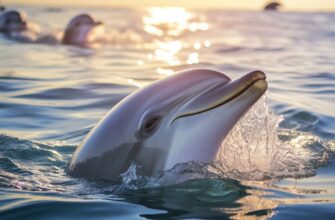Have you ever been on a boat and noticed dolphins swimming alongside you? It’s a magical experience to witness these intelligent creatures up close. But have you ever wondered why they do it? Dolphins’ behavior around boats has fascinated humans for generations, and there are many theories as to why they do it.
One thing is for certain, dolphins are curious animals who have a playful nature. In this article, we’ll explore the reasons behind these incredible marine mammal interactions and shed some light on their fascinating behavior.
- Key Takeaways:
- The Fascination with Dolphins and Boats
- The Fascination Continues
- The Curiosity of Dolphins
- The Role of Play in Dolphin Behavior
- Understanding Dolphin Behavior
- Reasons for Dolphin-Boat Interaction
- The Benefits and Risks of Dolphin-Boat Interaction
- Benefits
- Risks
- Minimizing Risks
- Responsible Boating Practices
- Conclusion
- Responsible Boating Practices
- FAQ
- Q: Why do dolphins swim with boats?
- Q: What is the fascination with dolphins and boats?
- Q: Are dolphins naturally curious?
- Q: How does dolphin behavior influence their interaction with boats?
- Q: Why do dolphins swim alongside boats?
- Q: What are the benefits and risks of dolphin-boat interaction?
- Q: How can we practice responsible boating around dolphins?
Key Takeaways:
- Dolphins are curious and playful creatures, which contributes to their interaction with boats.
- There are various reasons why dolphins swim alongside boats, including seeking shelter, using boat wakes for play, and feeding opportunities.
- Human activity can have a significant impact on dolphin behavior and well-being, emphasizing the need for responsible boating practices.
The Fascination with Dolphins and Boats
There is something undeniably captivating about the interaction between dolphins and boats. Whether you’re on a pleasure cruise or a fishing expedition, the sight of these graceful marine mammals swimming alongside your vessel is a true spectacle.
The reason for this interaction is rooted in the curious nature of dolphins. As highly intelligent and sociable animals, dolphins are known for their playful behavior and their interest in human activity.
Dolphins are often seen following boats, riding the pressure waves and wakes created by the vessels. They are also known to leap out of the water and perform aerial acrobatics, seemingly for the sheer joy of it. This behavior can be attributed to their natural curiosity and their desire to interact with their surroundings.
However, it’s important to understand that this fascination with boats can have a negative impact on dolphin behavior. Boats can cause disturbance to their feeding and resting patterns, and can even cause stress or injury. Therefore, it’s crucial to approach their interaction with care and respect.
It’s important to remember that these animals are wild creatures, and should be treated as such. While it may be tempting to feed or touch dolphins, this can cause them harm and disrupt their natural behavior. Instead, it’s best to simply observe from a safe distance and allow them to interact with their environment on their own terms.
The Fascination Continues
The interaction between dolphins and boats remains a subject of fascination for researchers and animal lovers alike. By understanding the curious nature of dolphins and the impact of our human activity, we can continue to appreciate these magnificent creatures while also ensuring their well-being.
The Curiosity of Dolphins
Dolphins are fascinating creatures with a natural curiosity that often leads them to interact with boats and other marine vessels. This behavior has puzzled scientists and boat enthusiasts alike, but it is believed to be linked to their playful nature and inquisitive mindset.
As highly social animals, dolphins enjoy engaging with other creatures in their environment, including humans and boats. They often swim alongside boats, jumping in and out of the water and riding the waves created by the vessel.
This playful behavior is thought to be a product of their inquisitive nature, which drives them to explore and interact with their surroundings. It is believed that dolphins may be attracted to the sounds and movements of boats and may even use them as a form of entertainment and stimulation.
Dolphins are highly intelligent creatures with complex communication methods and social structures. They have been known to engage in a variety of playful activities, including playing with seaweed, chasing bubbles, and even passing objects back and forth between themselves. Their curious and playful nature is an essential aspect of their behavior and contributes to their unique interaction with boats.
The Role of Play in Dolphin Behavior
Play is a crucial part of dolphin behavior, and it serves several important functions for these animals. It provides them with an opportunity to practice and develop their social and communication skills, form bonds with other dolphins, and explore their environment.
In addition, play is believed to play a critical role in the emotional well-being of dolphins, helping to reduce stress and anxiety and promoting a sense of joy and happiness. Their interaction with boats may be part of this play behavior, providing them with an exciting and stimulating outlet for their curiosity and creative expression.
Understanding Dolphin Behavior
Dolphins are highly intelligent marine mammals known for their playful nature and social structures. They are capable of complex communication through a variety of vocalizations, including whistles, clicks, and pulsed sounds. These sounds are used for a variety of purposes, such as echolocation for navigation and hunting, as well as to communicate with other members of their pod or to defend their territory.
In addition to vocalizations, dolphins also use body language and physical contact to communicate with one another. They are known to engage in a variety of social behaviors, such as playing, mating, and caring for their young.
Dolphin pods typically consist of anywhere from a few individuals to several dozen, with some species known to form larger groups of hundreds or even thousands of individuals. These pods are usually composed of both males and females, and they may remain together for years or even decades.
One reason dolphins may be attracted to boats is their curiosity. Dolphins are known for their inquisitive nature and often approach boats to investigate them. However, it’s important to remember that dolphins are wild animals and should be treated with respect and caution.
| Behavioral Trait | How it Influences Interaction with Boats |
|---|---|
| Curiosity | Dolphins may approach boats out of curiosity and investigate them. |
| Socialization | Dolphins may use boats as a social gathering point, interacting with other members of their pod or engaging in play. |
| Feeding | Dolphins may follow boats to take advantage of potential feeding opportunities, such as fishing boats or discarded food. |
It’s important to note that while dolphins may seem to be enjoying themselves when swimming alongside boats, human interaction can have a negative impact on their natural behaviors. Disturbing feeding and resting patterns, causing stress, and even injuring dolphins are all risks associated with reckless boating behavior. By understanding dolphin behavior and respecting their natural habitats, we can ensure their well-being and the continuation of their playful interactions with boats for years to come.
Reasons for Dolphin-Boat Interaction
There are a few reasons why dolphins may choose to swim alongside boats. One reason is seeking shelter from predators, as boats can provide a shield from larger marine animals.
Another reason is for the playful nature of dolphins. They are curious animals and enjoy interacting with other species, including humans. Boat wakes and prop wash can provide a fun and stimulating play area for dolphins.
Additionally, boats can sometimes indicate a food source for dolphins. They have been known to follow fishing boats in search of scraps or bait fish.
However, it’s important to note that human activity can also impact dolphin behavior. Boats can disrupt their feeding and resting patterns, causing stress and even injury. It’s essential to be aware of their presence and maintain a safe distance to ensure their well-being.
The Benefits and Risks of Dolphin-Boat Interaction
Dolphin-boat interaction can have both positive and negative effects on the behavior and well-being of dolphins. Understanding these benefits and risks is essential for responsible human interaction with these marine mammals.
Benefits
Interacting with boats can offer a range of benefits for dolphins. One of the most significant benefits is increased socialization. Dolphins are highly social animals and often swim in groups, which can be expanded through boat interaction. Boat wakes can also provide an opportunity for play, allowing the dolphins to jump and ride the waves. Furthermore, dolphins may use boats as a shelter from predators or to follow schools of fish that are attracted to the boats.
Another potential benefit is the potential for breeding opportunities. Boats can attract dolphins to areas with high fish concentrations, which can increase their chances of successful breeding. Additionally, dolphins may use the wake of boats to assist in mating.
Risks
Despite these potential benefits, there are also risks associated with dolphin-boat interaction. One of the primary risks is the disturbance of feeding and resting patterns. Boats, especially those that are operated irresponsibly, can disrupt the dolphins’ natural behavior and cause excessive stress. This can lead to a reduction in feeding, rest, and even mating opportunities, which can have detrimental effects on their overall health and well-being.
Another significant risk of boat interaction is the potential for injury. Dolphins may be unintentionally hit by boats, which can cause physical harm or even death. Additionally, boats can cause dolphins to become entangled in fishing lines or other debris, leading to injury or death.
It is important to note that the risks associated with dolphin-boat interaction are not exclusive to wild dolphins. Captive dolphins also experience similar risks when interacting with boats.
Minimizing Risks
While the risks associated with dolphin-boat interaction cannot be completely eliminated, there are steps that humans can take to minimize these risks. One of the most important steps is maintaining a safe distance from the dolphins. The National Oceanic and Atmospheric Administration suggests staying at least 50 yards away from dolphins when on a boat and 6 feet away when swimming.
It is also essential to avoid feeding or touching the dolphins as it can lead to dependence on humans and increase the risk of injury. Additionally, it is crucial to operate boats responsibly, following speed limits and avoiding areas where dolphins are known to feed or rest.
By following responsible boating practices, humans can minimize the risks associated with dolphin-boat interaction and ensure the well-being of these magnificent marine mammals.
Responsible Boating Practices
Dolphin-boat interaction can be an amazing experience for both humans and marine mammals. However, it is crucial to ensure that such interactions are responsibly managed to minimize the negative impact on dolphins and their natural behavior. Here are some guidelines to follow:
- Keep a safe distance: Be sure to stay at least 50 yards away from dolphins and reduce your speed when dolphins are present.
- Avoid feeding and touching: Do not feed dolphins or attempt to touch them, as this can disrupt their natural feeding and resting patterns.
- Reduce noise and avoid sudden movements: Loud noise and sudden movements can cause stress to dolphins.
- Observe, but don’t interfere: Enjoy the interaction from a safe distance and keep interactions brief to avoid disrupting their natural behavior.
It is important to acknowledge the impact of human activity on dolphin behavior and take proactive steps to minimize this impact. By following responsible boating practices, we can help preserve the playful nature of dolphins and their interactions with boats for generations to come.
Conclusion
In conclusion, dolphins swimming with boats may seem like a result of mischievous behavior, but it is actually rooted in their natural curiosity and playful nature. Their interactions with humans offer valuable opportunities for observation and research. However, it is important for us to remember that human activity can have a significant impact on dolphin behavior, and it is our responsibility to minimize any negative impacts.
Responsible Boating Practices
To ensure the well-being of these intelligent creatures, boaters should follow responsible practices when encountering dolphins. This includes maintaining a safe distance, not feeding or touching dolphins, and avoiding any actions that may disturb their natural behavior patterns.
By understanding dolphin behavior and recognizing the importance of responsible human interaction, we can enjoy the beauty of these majestic marine mammals while also protecting their habitat and well-being.
FAQ
Q: Why do dolphins swim with boats?
A: Dolphins swim with boats due to their playful nature and curiosity towards human activity. They are attracted to the movement and sounds of boats, often seeking interaction and entertainment.
Q: What is the fascination with dolphins and boats?
A: People are fascinated by the interactions between dolphins and boats as it provides a unique opportunity to observe these marine mammals up close. The sight of dolphins swimming alongside boats is both thrilling and captivating.
Q: Are dolphins naturally curious?
A: Yes, dolphins are known for their natural curiosity. Their inquisitive nature leads them to explore their surroundings, including boats and other human activity in the water.
Q: How does dolphin behavior influence their interaction with boats?
A: Dolphin behavior, such as their social structures, communication methods, and playful nature, can influence their interaction with boats. Their curiosity and desire to engage with their environment often leads them to swim alongside boats.
Q: Why do dolphins swim alongside boats?
A: Dolphins may swim alongside boats for various reasons. They might seek shelter from predators, use boat wakes for play and surfing, or take advantage of potential feeding opportunities created by the disturbance caused by the boat.
Q: What are the benefits and risks of dolphin-boat interaction?
A: Dolphin-boat interaction can provide benefits such as increased socialization and breeding opportunities for dolphins. However, there are also risks involved, including disturbance to their feeding and resting patterns, stress, and potential injury.
Q: How can we practice responsible boating around dolphins?
A: To minimize negative impacts on dolphins, it is important to maintain a safe distance from them, avoid feeding or touching them, and follow guidelines for responsible boating practices. Respecting their natural behavior and habitat is crucial for their well-being.


